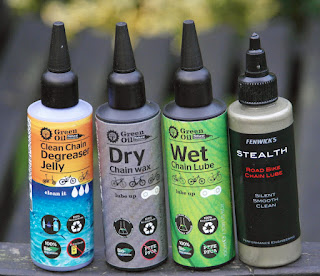Spare cone cum spacer arrived
for the Halo Aerotrack hub, so I wasted no time in drizzling some green oil eco
grease on the threads and winding it home. After a bit of deliberation, I opted
to run the Titanium sprocket, checking this had a generous helping of
waterproof synthetic grease.
Sat between it and the hub’s
aluminium alloy threads. In this instance I’ve gone for White Lightning crystal
grease https://www.sevendaycyclist.com/white-lightning-crystal-grease
which seems particularly dependable.
However, given this bike serves year round, I will be inspecting more
frequently than those adorning the On-one Inbred hub. Remiss of me.
Seems the right hand EAI
sprocket and lockring have formed a particularly stubborn union with the
aluminium alloy hub threads. I’ve tried
liberal marinades of high quality penetrant/release sprays before
introducing lockring spanners, chain whips and primal grunting. Nope, won’t
budge. So I’ve put it down and will revisit when inspiration strikes.
Where possible, I like to keep
components going-if they’re basically in good order but I’m beginning to
wonder-if I’m going the wheel build route, salvage might be false economy. The
last thing I want is a freshly built wheel, only for the hub to conk out in
spectacular fashion shortly afterward!
So, I am researching alternatives.
System EX units were nicely executed budget options, though it’s not clear if
they’re still in production. Three times the price but Surly also produce some
nice small flange double fixed hubs with more sophisticated
bearings…Nonetheless, in the meantime, I’m relieved I held on to the Halo and
will make very good use of it.
Staying on the subject of
lubes and other fluid tooling, Green Oil have sent us their new Ecospray lube.
PTFE and petrochemical free. PTFE (often known as Teflon), was discovered by
accident in the 1930s are remains pretty ubiquitous. Not just in engineering
applications either; non-stick cooking utensils, carpets and socks being three
that immediately spring to mind.
On the plus side, Teflon lubes
and greases are cheap, surprisingly effective and reasonably durable. However,
it’s not kind to organic/aquatic life and is widely thought to be connected to
heart, thyroid and lung conditions.
Repacking hub bearings,
headsets, pedals and bottom bracket threads every few months and doing so eight
hours a day, 5/6 days every week for thirty years present two very different
levels of risk.
The same goes for classic
car/motorcycle enthusiasts and professional mechanics, when talking exposure to
swarf and other carcinogens found in used motor oil.
I wear latex/similar
examination gloves when working with petrochemicals. I must admit that I’m not
so fastidious when giving cables and mechanisms a quick squirt, or lubricating
chains.
Well, I wasn’t surprised to
learn the stock is that, used in their wet chain lube. However, achieving the
spray-able consistency requires a greater ratio of plant based solvent.
Some folks will argue that
butane/propane propellant put a dent in the eco-friendly credentials but I’m
assure quantities involved present minimal impact to environment and user
alike.
So far, I’ve used it on the
teenage dream’s Regina freewheel, cleat mechanisms and assorted brake cables.
The rich yellowy layer could almost pass for a heavyweight PTFE potion, the
sort that will, in a pinch double as a summer chain lube. Several weeks and
more varied use should give a better indication of its strengths and, where
appropriate, weaknesses/limitations.











